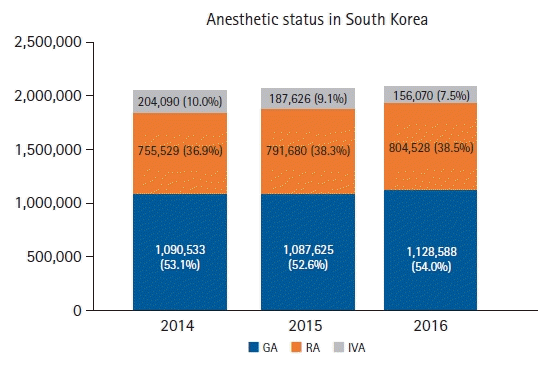1. Shin YS. 30 years of Korean Health Insurance- its success, failure, and future directions. J Korean Med Assoc. 2007; 50:568–71.
2. Kim H, Yeo J, Kang S, Jung Y, Lee S. Review of the Korean health care system performance during 2000~2010 and policy implications based on OECD Health data. Sejong: Korea Institute for Health and Social Affairs;2012. Report No.: 2012-66.
3. Kim Y, Kim JM, Lee SG, Lee KY, Hong KH, Lee KH, et al. The state of anesthetic services in Korea: a national survey of the status of anesthesia provider in the 2011-2013 period. J Korean Med Sci. 2016; 31:131–8.
4. Komatsu R, Kasuya Y, Yogo H, Sessler DI, Mascha E, Yang D, et al. Learning curves for bag-and-mask ventilation and orotracheal intubation: an application of the cumulative sum method. Anesthesiology. 2010; 112:1525–31.
5. Garza AG, Gratton MC, Coontz D, Noble E, Ma OJ. Effect of paramedic experience on orotracheal intubation success rates. J Emerg Med. 2003; 25:251–6.
6. Rai MR, Dering A, Verghese C. The Glidescope system: a clinical assessment of performance. Anaesthesia. 2005; 60:60–4.
7. Savoldelli GL, Schiffer E, Abegg C, Baeriswyl V, Clergue F, Waeber JL. Learning curves of the Glidescope, the McGrath and the Airtraq laryngoscopes: a manikin study. Eur J Anaesthesiol. 2009; 26:554–8.
8. Kim CU, Lee CH, Yoon JY, Rhee SK. Ultrasound-guided axillary brachial plexus block, performed by orthopedic surgeons. J Korean Orthop Assoc. 2018; 53:513–21.
9. Strub B, Sonderegger J, Von Campe A, Grünert J, Osterwalder JJ. What benefits does ultrasound-guided axillary block for brachial plexus anaesthesia offer over the conventional blind approach in hand surgery? J Hand Surg Eur Vol. 2011; 36:778–86.
10. Pawa A, El-Boghdadly K. Regional anesthesia by nonanesthesiologists. Curr Opin Anaesthesiol. 2018; 31:586–92.
11. Herring AA. Bringing ultrasound-guided regional anesthesia to emergency medicine. AEM Educ Train. 2017; 1:165–8.
12. Chen XX, Trivedi V, AlSaflan AA, Todd SC, Tricco AC, McCartney CJ, et al. Ultrasound-guided regional anesthesia simulation training: a systematic review. Reg Anesth Pain Med. 2017; 42:741–50.
13. Kopacz DJ, Neal JM, Pollock JE. The regional anesthesia “learning curve”. What is the minimum number of epidural and spinal blocks to reach consistency? Reg Anesth. 1996; 21:182–90.
14. Charuluxananan S, Kyokong O, Somboonviboon W, Pothimamaka S. Learning manual skills in spinal anesthesia and orotracheal intubation: is there any recommended number of cases for anesthesia residency training program? J Med Assoc Thai. 2001; 84 Suppl 1:S251–5.
15. Alburquerque M, Smarrelli A, Montesinos JC, Carreño SO, Fernandez AZ, García AV, et al. Outcomes of colonoscopy with non-anesthesiologist-administered propofol (NAAP): an equivalence trial. Endosc Int Open. 2021; 9:E1070–6.
16. Cabadas Avión R, Baluja A, Ojea Cendón M, Leal Ruiloba MS, Vázquez López S, Rey Martínez M, et al. Effectiveness and safety of gastrointestinal endoscopy during a specific sedation training program for non-anesthesiologists. Rev Esp Enferm Dig. 2019; 111:199–208.
17. Ferreira AO, Torres J, Barjas E, Nunes J, Glória L, Ferreira R, et al. Non-anesthesiologist administration of propofol sedation for colonoscopy is safe in low risk patients: results of a noninferiority randomized controlled trial. Endoscopy. 2016; 48:747–53.
18. Daza JF, Tan CM, Fielding RJ, Brown A, Farrokhyar F, Yang I. Propofol administration by endoscopists versus anesthesiologists in gastrointestinal endoscopy: a systematic review and meta-analysis of patient safety outcomes. Can J Surg. 2018; 61:226–36.
19. Roh WS, Kim DK, Jeon YH, Kim SH, Lee SC, Ko YK, et al. Analysis of anesthesia-related medical disputes in the 2009-2014 period using the Korean Society of Anesthesiologists database. J Korean Med Sci. 2015; 30:207–13.
20. Khan HA, Umar M, Tul-Bushra H, Nisar G, Bilal M, Umar S. Safety of non-anaesthesiologist-administered propofol sedation in ERCP. Arab J Gastroenterol. 2014; 15:32–5.
21. Rex DK, Deenadayalu VP, Eid E, Imperiale TF, Walker JA, Sandhu K, et al. Endoscopist-directed administration of propofol: a worldwide safety experience. Gastroenterology. 2009; 137:1229–37.
22. Perel A. Non-anaesthesiologists should not be allowed to administer propofol for procedural sedation: a Consensus Statement of 21 European National Societies of Anaesthesia. Eur J Anaesthesiol. 2011; 28:580–4.
23. Lim JH. Sedation during endoscopy, can we take it easy? Korean J Helicobacter Up Gastrointest Res. 2017; 17:163–5.
24. Kim KK, Choi JW, Lee ES. The state of medical malpractice caused by private practice physicians (2010-2012): analysis through incident reports at Korean Medical Association Medical Indemnities Mutuals. J Korean Med Assoc. 2015; 58:336–48.
25. Im BH. Analysis of medical disputes precedent. J Korea Contents Assoc. 2010; 10:294–303.
26. Yang SH, Cho HS, Lee SH, Shon MS. Factors affecting the settlement amount of medical malpractice claims. J Korean Acad Fam Med. 1998; 19:604–20.
27. Venning P, Durie A, Roland M, Roberts C, Leese B. Randomised controlled trial comparing cost effectiveness of general practitioners and nurse practitioners in primary care. BMJ. 2000; 320:1048–53.
28. Lewis SR, Nicholson A, Smith AF, Alderson P. Physician anaesthetists versus non-physician providers of anaesthesia for surgical patients. Cochrane Database Syst Rev. 2014; (7):CD010357.





 PDF
PDF Citation
Citation Print
Print



 XML Download
XML Download